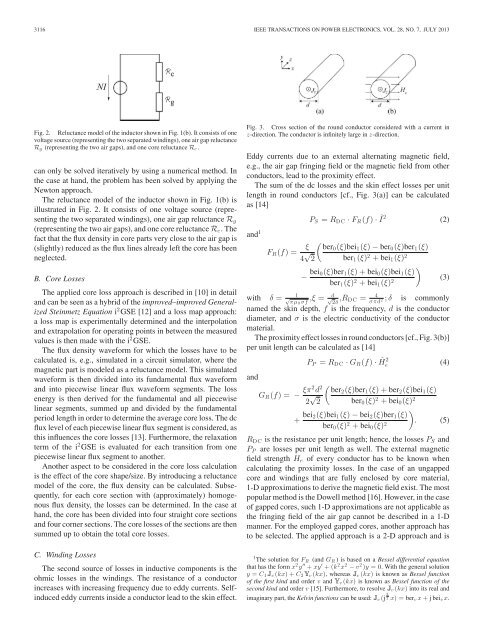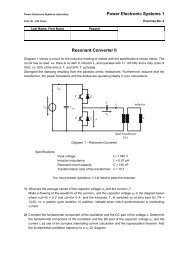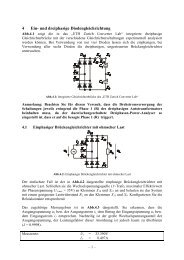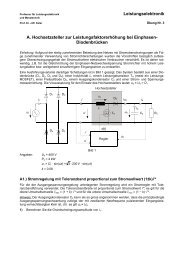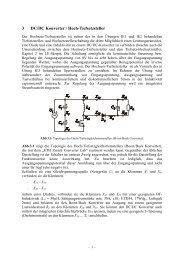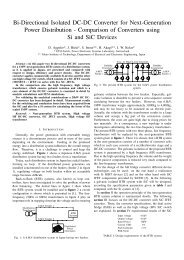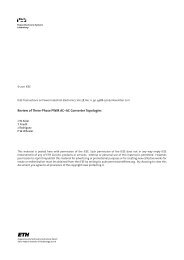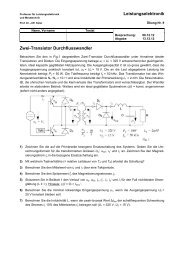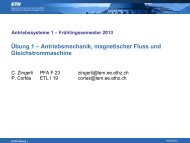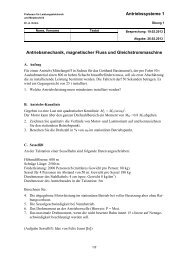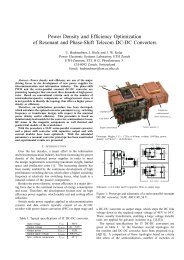Optimal Design of LCL Harmonic Filters for Three-Phase PFC ...
Optimal Design of LCL Harmonic Filters for Three-Phase PFC ...
Optimal Design of LCL Harmonic Filters for Three-Phase PFC ...
You also want an ePaper? Increase the reach of your titles
YUMPU automatically turns print PDFs into web optimized ePapers that Google loves.
3116 IEEE TRANSACTIONS ON POWER ELECTRONICS, VOL. 28, NO. 7, JULY 2013<br />
Fig. 2. Reluctance model <strong>of</strong> the inductor shown in Fig. 1(b). It consists <strong>of</strong> one<br />
voltage source (representing the two separated windings), one air gap reluctance<br />
R g (representing the two air gaps), and one core reluctance R c .<br />
can only be solved iteratively by using a numerical method. In<br />
the case at hand, the problem has been solved by applying the<br />
Newton approach.<br />
The reluctance model <strong>of</strong> the inductor shown in Fig. 1(b) is<br />
illustrated in Fig. 2. It consists <strong>of</strong> one voltage source (representing<br />
the two separated windings), one air gap reluctance R g<br />
(representing the two air gaps), and one core reluctance R c .The<br />
fact that the flux density in core parts very close to the air gap is<br />
(slightly) reduced as the flux lines already left the core has been<br />
neglected.<br />
B. Core Losses<br />
The applied core loss approach is described in [10] in detail<br />
and can be seen as a hybrid <strong>of</strong> the improved–improved Generalized<br />
Steinmetz Equation i 2 GSE [12] and a loss map approach:<br />
a loss map is experimentally determined and the interpolation<br />
and extrapolation <strong>for</strong> operating points in between the measured<br />
values is then made with the i 2 GSE.<br />
The flux density wave<strong>for</strong>m <strong>for</strong> which the losses have to be<br />
calculated is, e.g., simulated in a circuit simulator, where the<br />
magnetic part is modeled as a reluctance model. This simulated<br />
wave<strong>for</strong>m is then divided into its fundamental flux wave<strong>for</strong>m<br />
and into piecewise linear flux wave<strong>for</strong>m segments. The loss<br />
energy is then derived <strong>for</strong> the fundamental and all piecewise<br />
linear segments, summed up and divided by the fundamental<br />
period length in order to determine the average core loss. The dc<br />
flux level <strong>of</strong> each piecewise linear flux segment is considered, as<br />
this influences the core losses [13]. Furthermore, the relaxation<br />
term <strong>of</strong> the i 2 GSE is evaluated <strong>for</strong> each transition from one<br />
piecewise linear flux segment to another.<br />
Another aspect to be considered in the core loss calculation<br />
is the effect <strong>of</strong> the core shape/size. By introducing a reluctance<br />
model <strong>of</strong> the core, the flux density can be calculated. Subsequently,<br />
<strong>for</strong> each core section with (approximately) homogenous<br />
flux density, the losses can be determined. In the case at<br />
hand, the core has been divided into four straight core sections<br />
and four corner sections. The core losses <strong>of</strong> the sections are then<br />
summed up to obtain the total core losses.<br />
C. Winding Losses<br />
The second source <strong>of</strong> losses in inductive components is the<br />
ohmic losses in the windings. The resistance <strong>of</strong> a conductor<br />
increases with increasing frequency due to eddy currents. Selfinduced<br />
eddy currents inside a conductor lead to the skin effect.<br />
Fig. 3. Cross section <strong>of</strong> the round conductor considered with a current in<br />
z-direction. The conductor is infinitely large in z-direction.<br />
Eddy currents due to an external alternating magnetic field,<br />
e.g., the air gap fringing field or the magnetic field from other<br />
conductors, lead to the proximity effect.<br />
The sum <strong>of</strong> the dc losses and the skin effect losses per unit<br />
length in round conductors [cf., Fig. 3(a)] can be calculated<br />
as [14]<br />
and 1 F R (f) = ξ<br />
4 √ 2<br />
with δ =<br />
1 √ πμ0 σf ,ξ =<br />
P S = R DC · F R (f) · Î2 (2)<br />
( ber0 (ξ)bei 1 (ξ) − ber 0 (ξ)ber 1 (ξ)<br />
ber 1 (ξ) 2 + bei 1 (ξ) 2<br />
− bei )<br />
0(ξ)ber 1 (ξ)+bei 0 (ξ)bei 1 (ξ)<br />
ber 1 (ξ) 2 + bei 1 (ξ) 2<br />
(3)<br />
√ d<br />
2δ<br />
,R DC = 4<br />
σπd<br />
; δ is commonly<br />
2<br />
named the skin depth, f is the frequency, d is the conductor<br />
diameter, and σ is the electric conductivity <strong>of</strong> the conductor<br />
material.<br />
The proximity effect losses in round conductors [cf., Fig. 3(b)]<br />
per unit length can be calculated as [14]<br />
P P = R DC · G R (f) · Ĥ2 e (4)<br />
and<br />
G R (f) = − ξπ2 d 2 (<br />
2 √ ber2 (ξ)ber 1 (ξ)+ber 2 (ξ)bei 1 (ξ)<br />
2 ber 0 (ξ) 2 + bei 0 (ξ) 2<br />
+ bei )<br />
2(ξ)bei 1 (ξ) − bei 2 (ξ)ber 1 (ξ)<br />
ber 0 (ξ) 2 + bei 0 (ξ) 2 . (5)<br />
R DC is the resistance per unit length; hence, the losses P S and<br />
P P are losses per unit length as well. The external magnetic<br />
field strength H e <strong>of</strong> every conductor has to be known when<br />
calculating the proximity losses. In the case <strong>of</strong> an ungapped<br />
core and windings that are fully enclosed by core material,<br />
1-D approximations to derive the magnetic field exist. The most<br />
popular method is the Dowell method [16]. However, in the case<br />
<strong>of</strong> gapped cores, such 1-D approximations are not applicable as<br />
the fringing field <strong>of</strong> the air gap cannot be described in a 1-D<br />
manner. For the employed gapped cores, another approach has<br />
to be selected. The applied approach is a 2-D approach and is<br />
1 The solution <strong>for</strong> F R (and G R ) is based on a Bessel differential equation<br />
that has the <strong>for</strong>m x 2 y ′′ + xy ′ +(k 2 x 2 − v 2 )y =0. With the general solution<br />
y = C 1 J v (kx)+C 2 Y v (kx), whereas J v (kx) is known as Bessel function<br />
<strong>of</strong> the first kind and order v and Y v (kx) is known as Bessel function <strong>of</strong> the<br />
second kind and order v [15]. Furthermore, to resolve J v (kx) into its real and<br />
imaginary part, the Kelvin functions can be used: J v (j 3 2 x) =ber v x + jbei v x.


